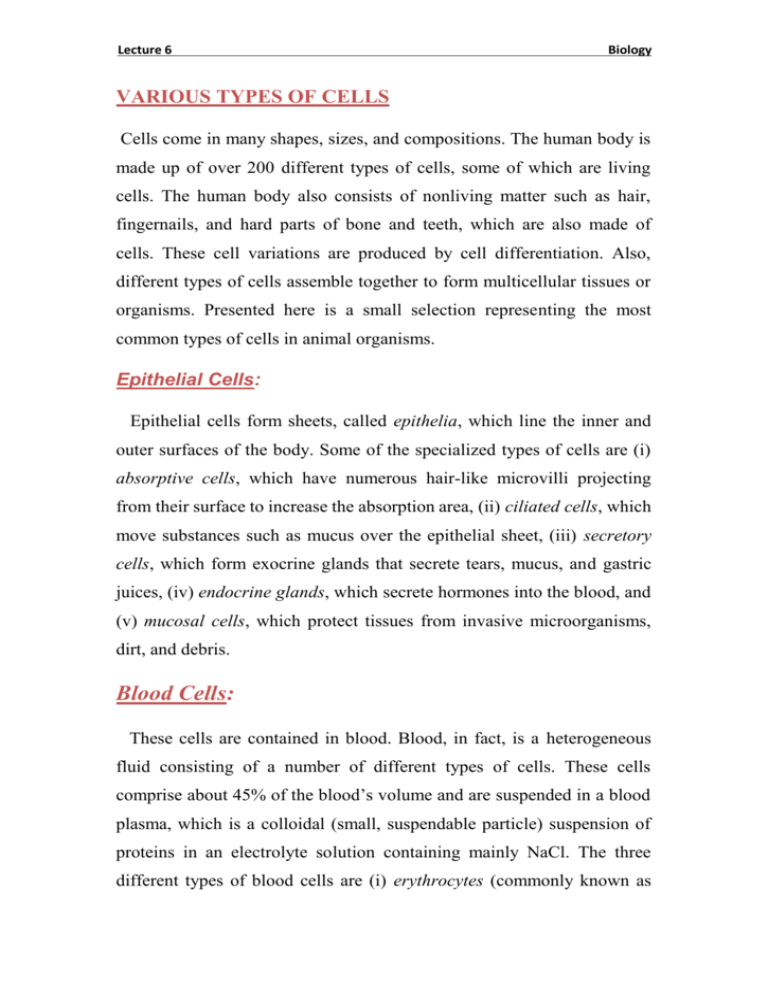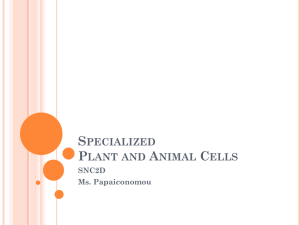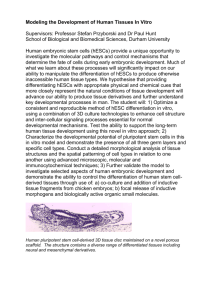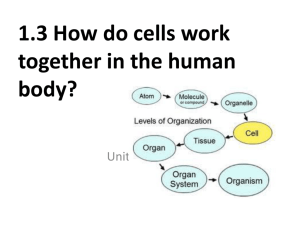pubdoc_12_11134_1727
advertisement

Lecture 6 Biology VARIOUS TYPES OF CELLS Cells come in many shapes, sizes, and compositions. The human body is made up of over 200 different types of cells, some of which are living cells. The human body also consists of nonliving matter such as hair, fingernails, and hard parts of bone and teeth, which are also made of cells. These cell variations are produced by cell differentiation. Also, different types of cells assemble together to form multicellular tissues or organisms. Presented here is a small selection representing the most common types of cells in animal organisms. Epithelial Cells: Epithelial cells form sheets, called epithelia, which line the inner and outer surfaces of the body. Some of the specialized types of cells are (i) absorptive cells, which have numerous hair-like microvilli projecting from their surface to increase the absorption area, (ii) ciliated cells, which move substances such as mucus over the epithelial sheet, (iii) secretory cells, which form exocrine glands that secrete tears, mucus, and gastric juices, (iv) endocrine glands, which secrete hormones into the blood, and (v) mucosal cells, which protect tissues from invasive microorganisms, dirt, and debris. Blood Cells: These cells are contained in blood. Blood, in fact, is a heterogeneous fluid consisting of a number of different types of cells. These cells comprise about 45% of the blood’s volume and are suspended in a blood plasma, which is a colloidal (small, suspendable particle) suspension of proteins in an electrolyte solution containing mainly NaCl. The three different types of blood cells are (i) erythrocytes (commonly known as Lecture 6 Biology red blood cells; often abbreviated as RBC), (ii) leucocytes (commonly known as white blood cells), and (iii) thrombocytes (also known as platelets). Erythrocytes or red blood cells are very small cells, 7–9µm in diameter, with a biconcave, discotic shape. They usually have no nucleus. One cubic centimeter of blood contains about 5 billion erythrocytes, the actual number depending on a number of factors such as age, gender, and health. They contain an oxygen-binding protein called hemoglobin and thus perform the important function of transporting O2 and CO2. Leucocytes or white blood cells provide protection against infection. They exist in a ratio of one white blood cell for about every 1000 red blood cells. They are usually larger than red blood cells. There are a number of different types of leucocytes, including (i) lymphocytes, which are responsible for immune responses (the two kinds of lymphocytes are T cells, which are responsible for cell-mediated immunity, and B cells, which produce antibodies), and (ii) macrophages and neutrophils, which move to sites of infection where they ingest bacteria and debris. Platelets are organelles devoid of a nucleus and 2–5µm in diameter (smaller than red blood cells). They produce specific substances for blood coagulation. Muscle Cells: These specialized cells form muscle tissues such as skeletal muscles to move joints, cardiac muscles to produce heartbeat, and smooth muscle tissues found around the internal organs and large blood vessels. Muscle cells produce mechanical force by their contraction and relaxation. Lecture 6 Biology Nerve Cells or Neurons: Neurons are cells specializing in communication. The brain and spinal cord, for example, are composed of a network of neurons that extend out from the spinal cord into the body. Sensory Cells: These cells form the sensory organs such as (a) hair cells of the inner ear, which act as detectors of sound, and (b) retina, where rod cells specialize in responding to light. The rod cells contain a photosensitive region consisting of light-sensitive pigments (chromophores) called rhodopsin. Germ Cells: Germ cells are haploids (cells containing one member or a copy of each pair of chromosome).The two types of germ cells specialized for sexual fusion, also called gametes, are (i) a larger, nonmotile (nonmoving) cell called the egg (or ovum) from a female and (ii) a small, motile cell referred to as sperm (or spermatozoon) from a male. A sperm fuses with an egg to form a new diploid organism (containing both chromosomes). Bacteria are another example of haploid cells. Stem Cells: Another type of cell that has received considerable attention during recent years is the stem cell. Stem cells can be thought of as blank cells that have yet to become specialized (differentiated), giving them the characteristics of a particular type of cell such as the ones described above. Lecture 6 Biology Stem cells thus have the ability to become any type of cell to form any type of tissue (bone, muscle, nerve, etc.). The three different types of stem cells are (i) embryonic stem cells, which come from embryos, (ii) embryonic germ cells, which come from testes, and (iii) adult stem cells, which come from bone marrow. Embryonic stem cells are classified as pluripotent because they can become any type of cell. Adult stem cells, on the other hand, are multipotent in that they are already somewhat specialized. The pluripotent type (which are in the early stage of specialization after several cell divisions) are more useful than the adult stem cells. However, recent research suggests that multipotent adult stem cells can have pluripotent capability. Stem cells can provide a solution in regard to curing diseases caused by cell failure and repairing tissues that do not repair by themselves by allowing one to produce appropriate cells and grow needed tissues. Some of the diseases for which stem cell research is projected to benefit are heart damage, spinal cord injuries, Parkinson’s disease, leukemia, and diabetes.









